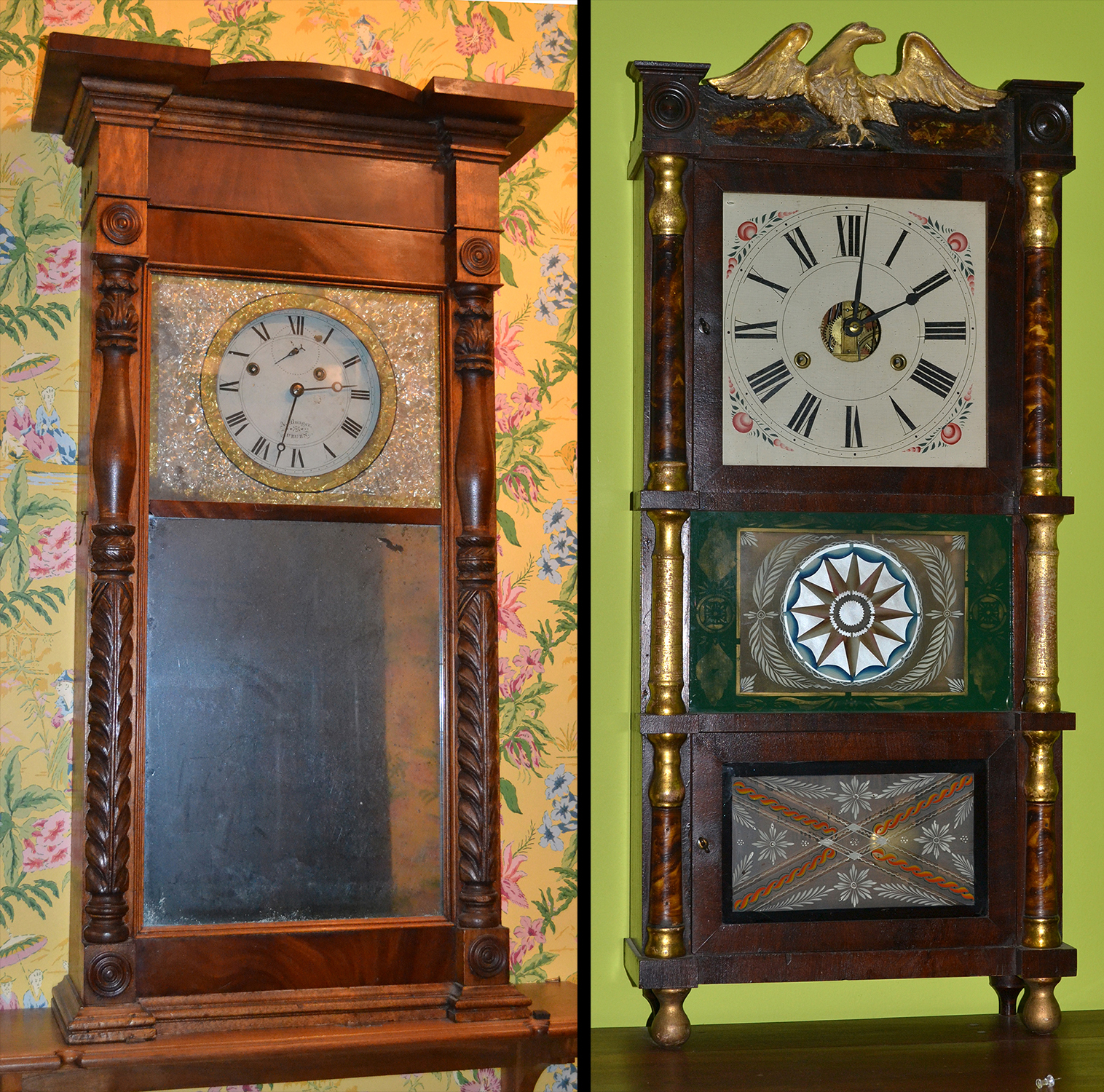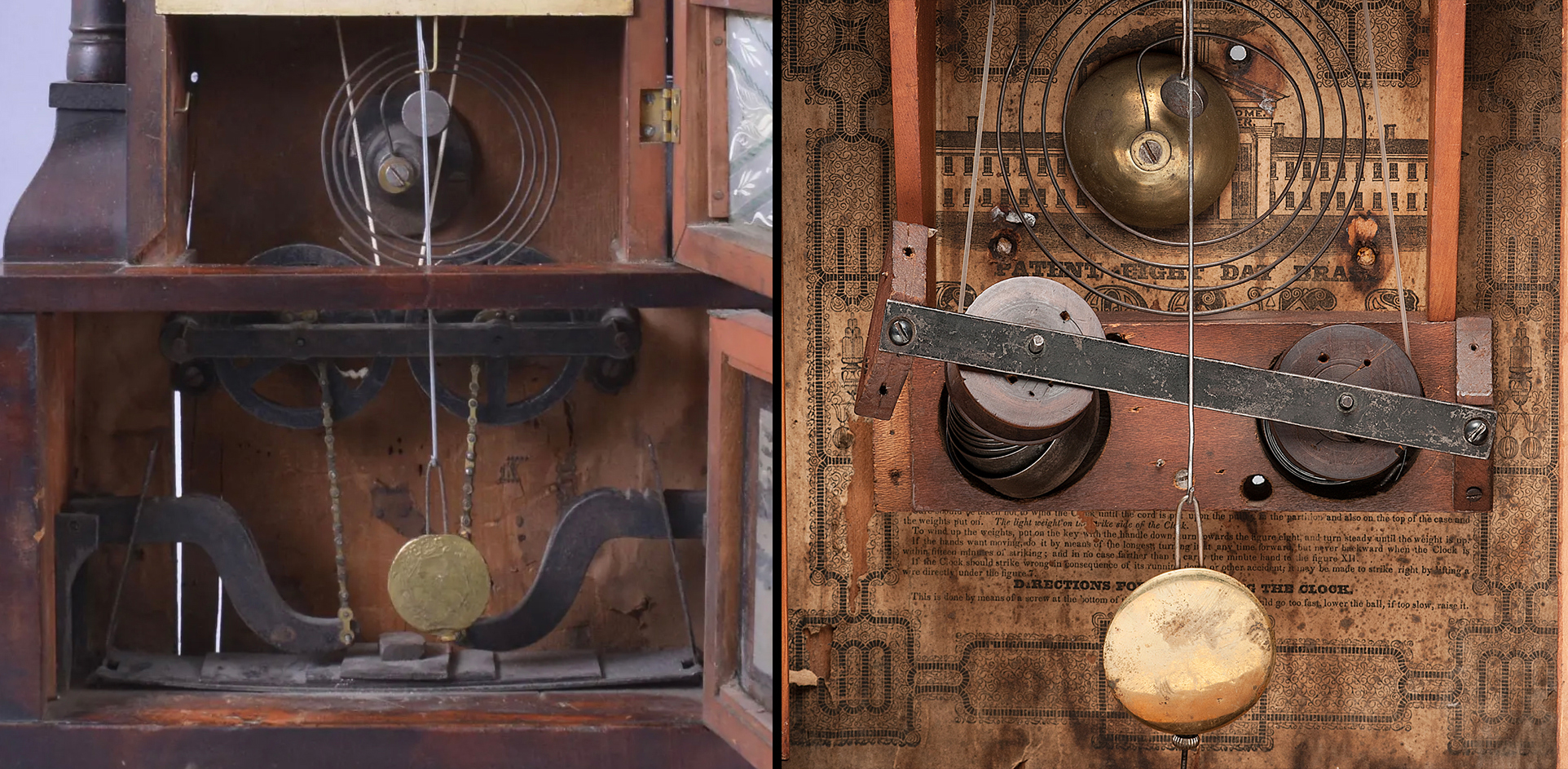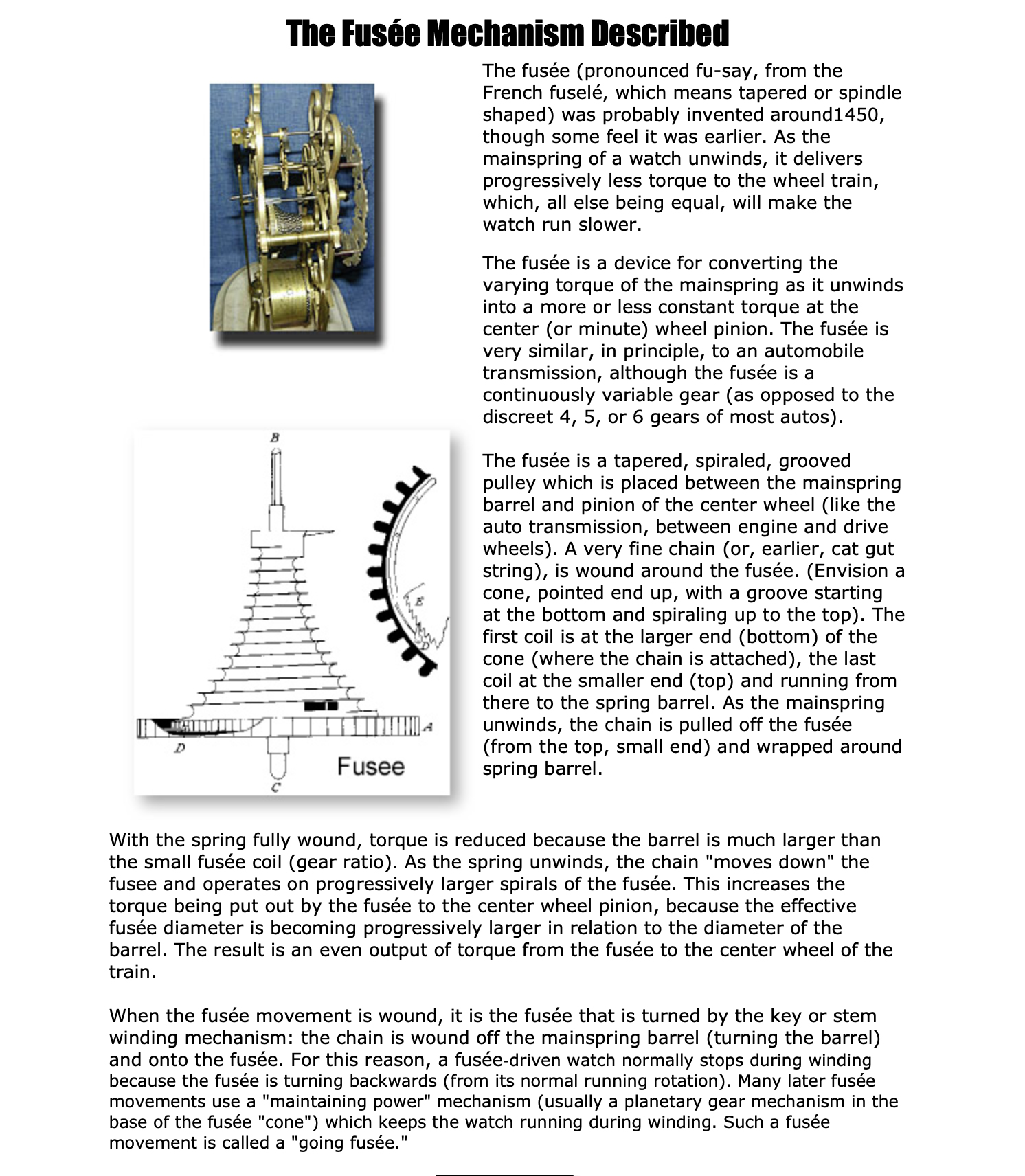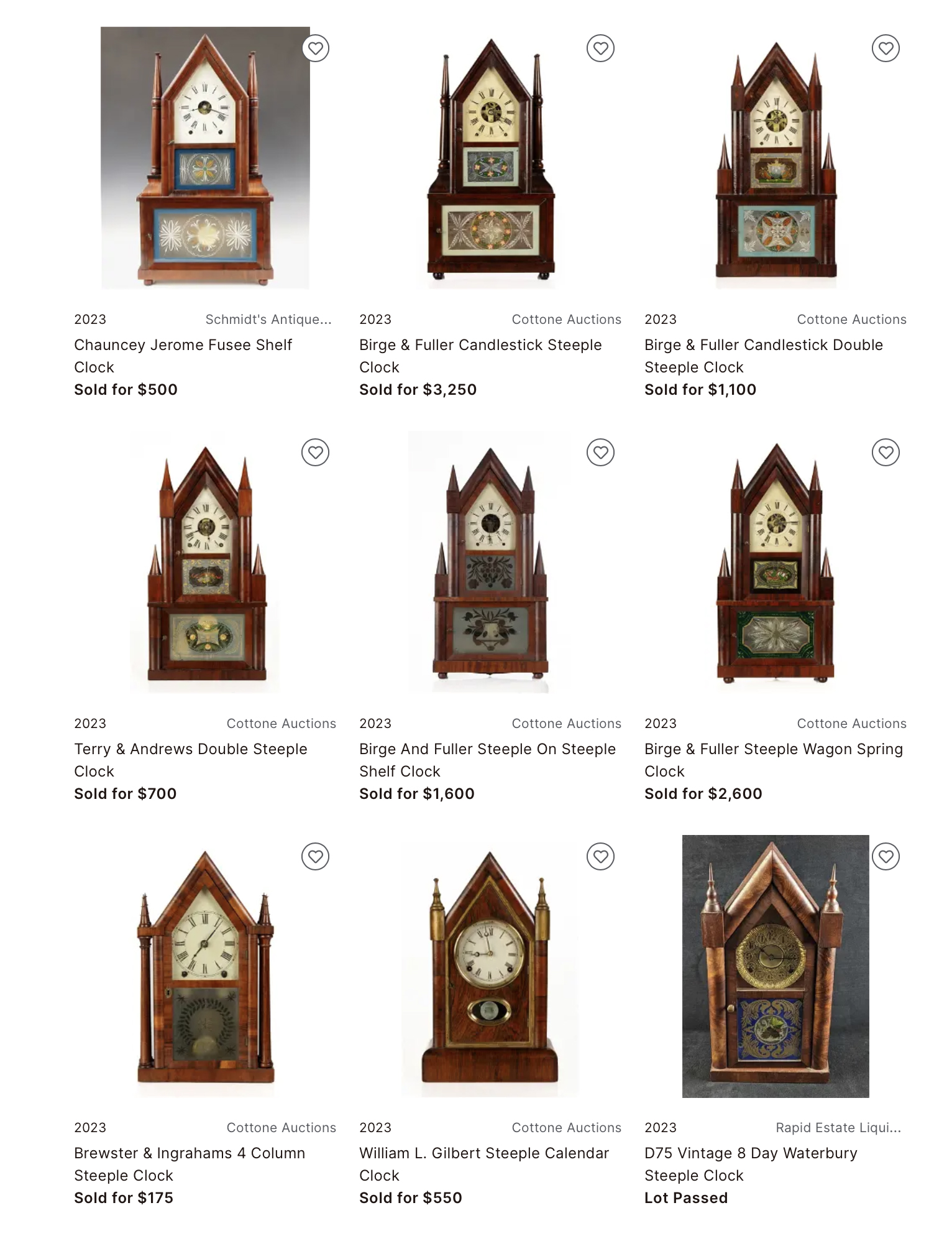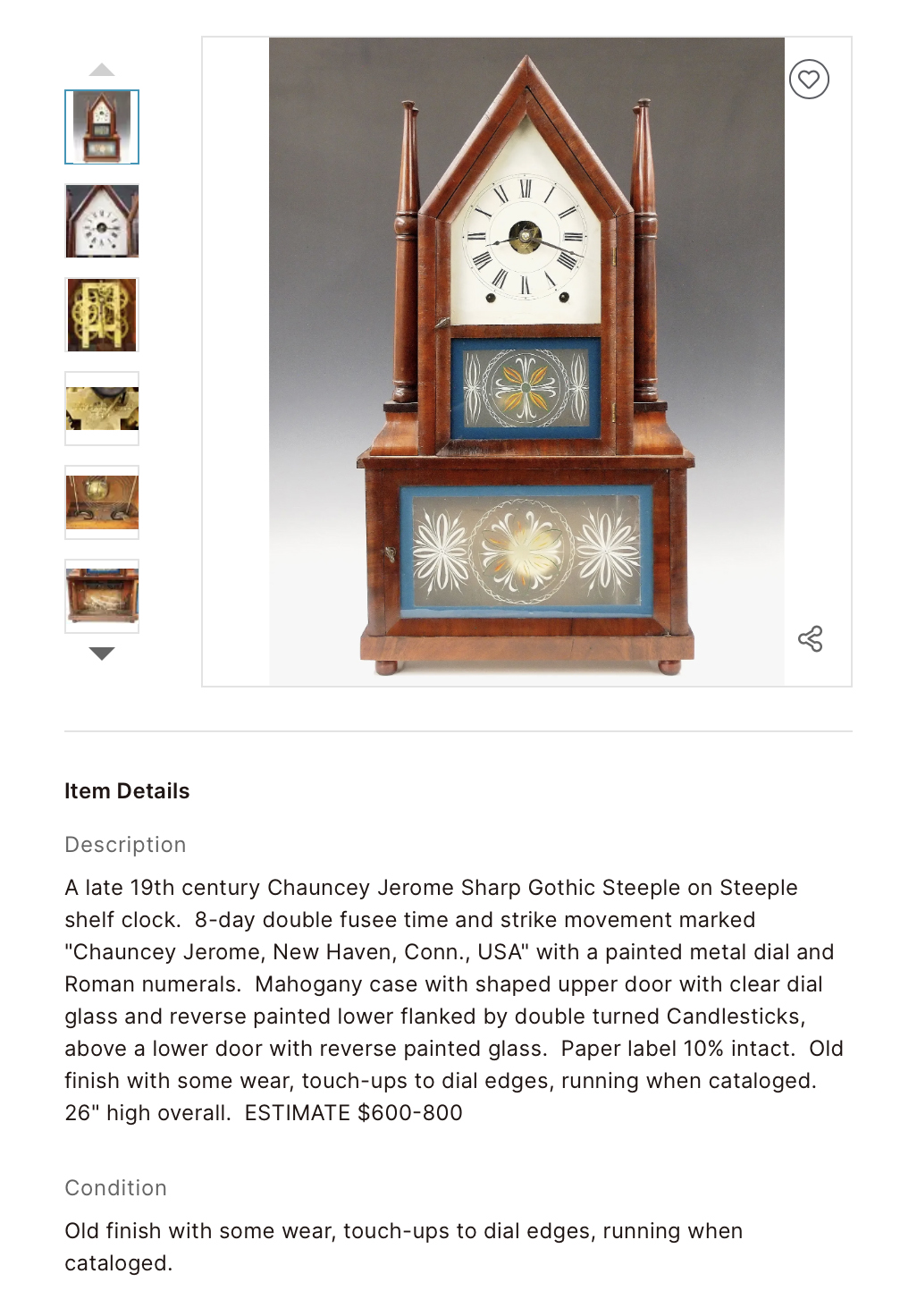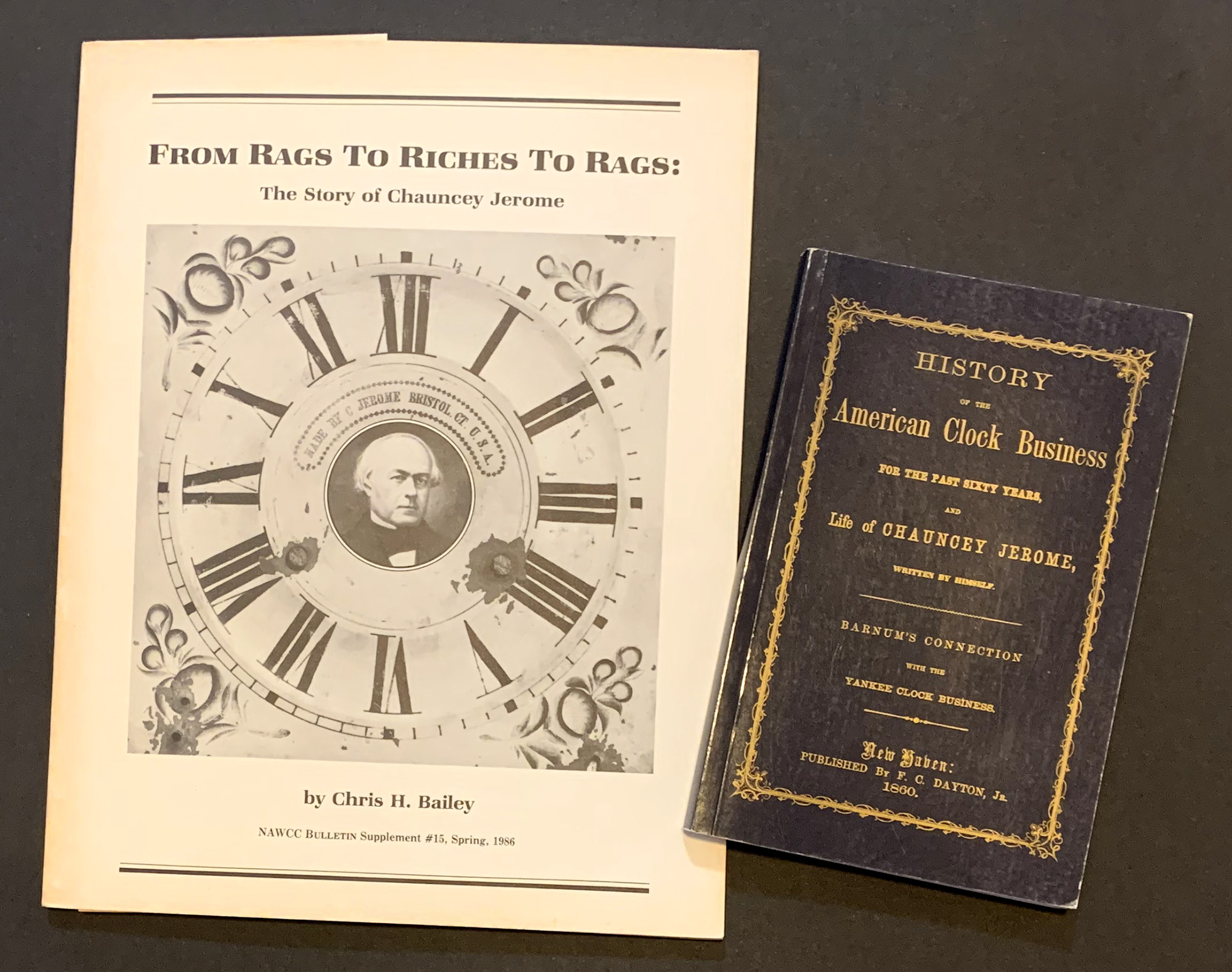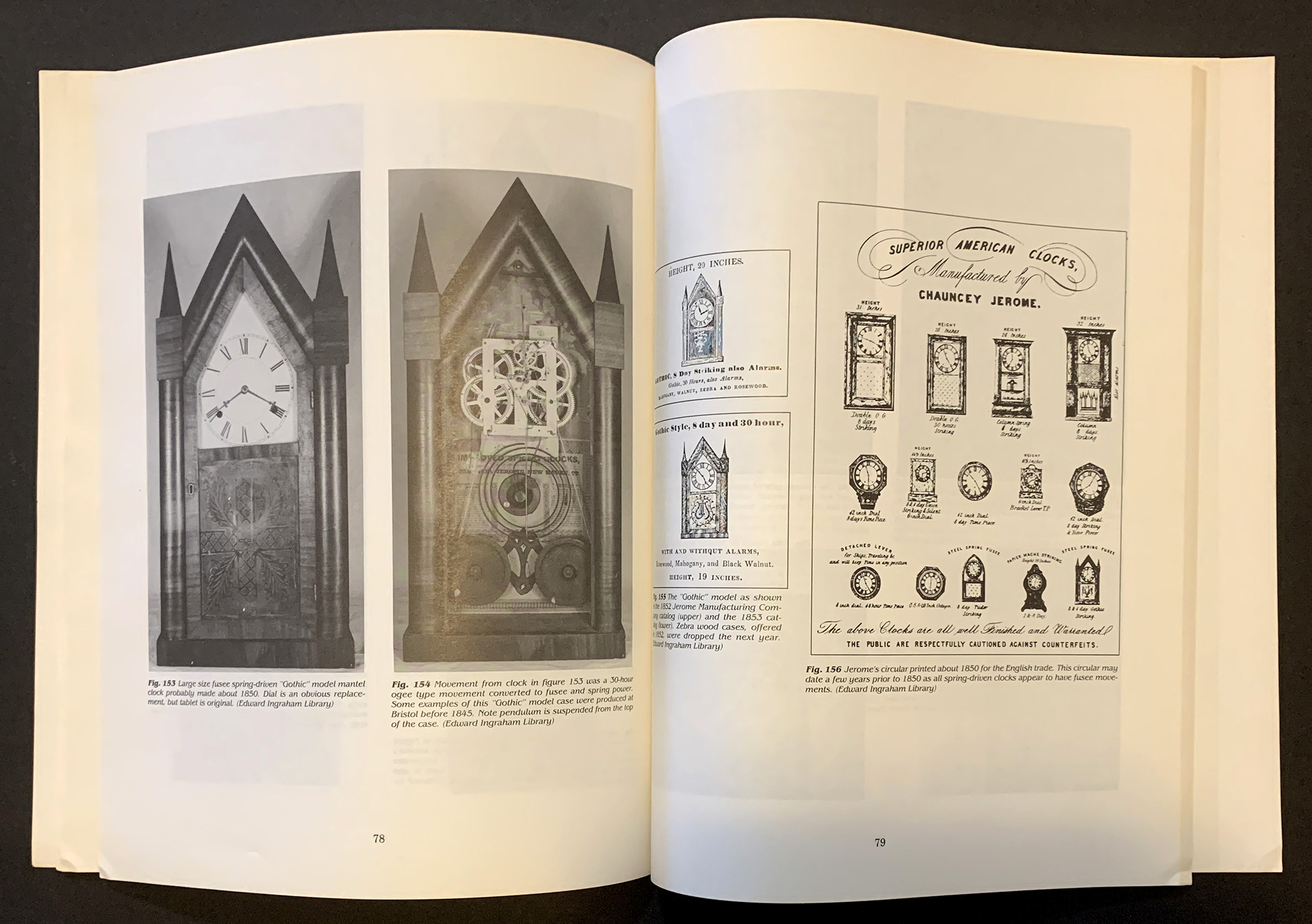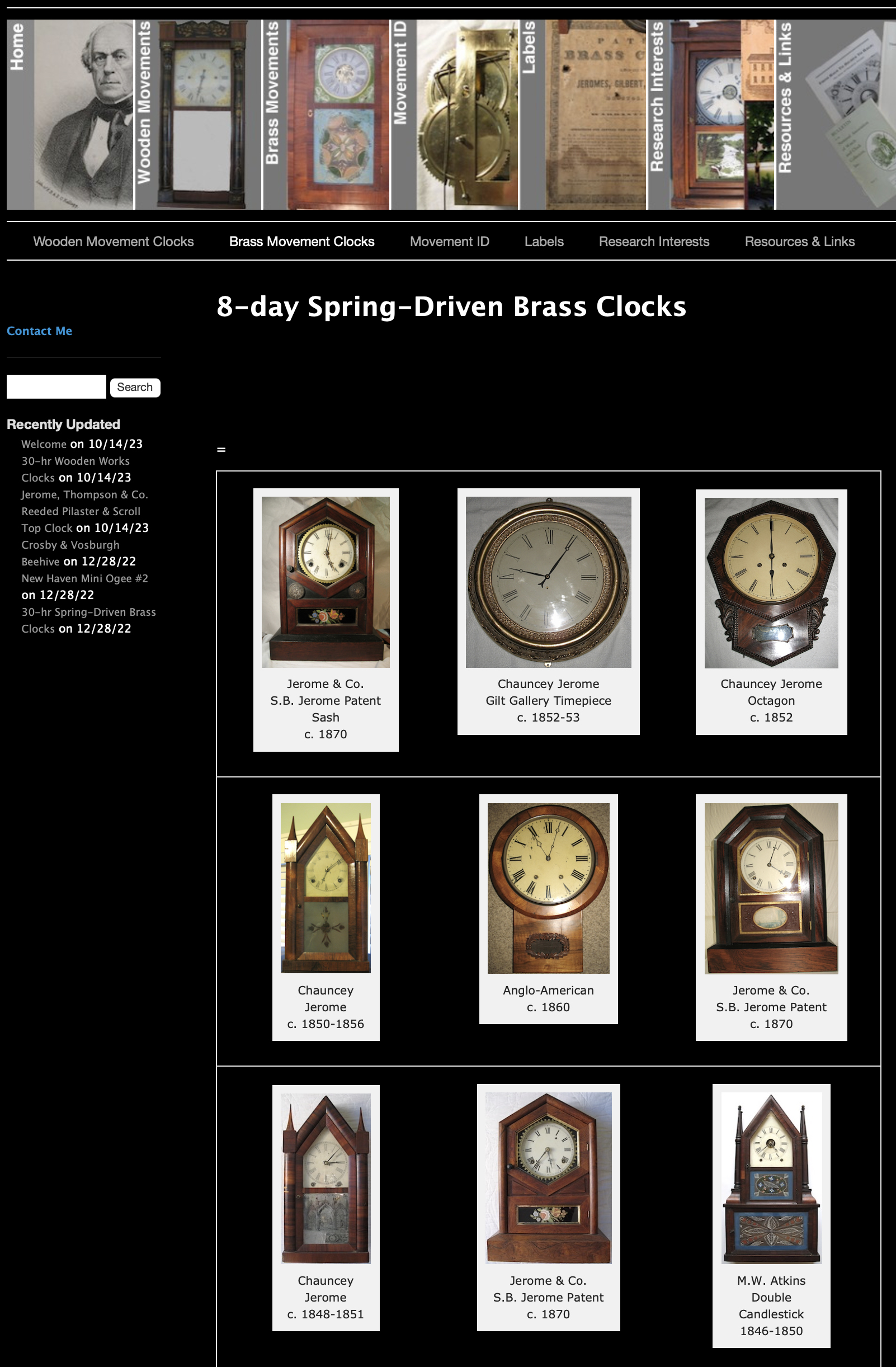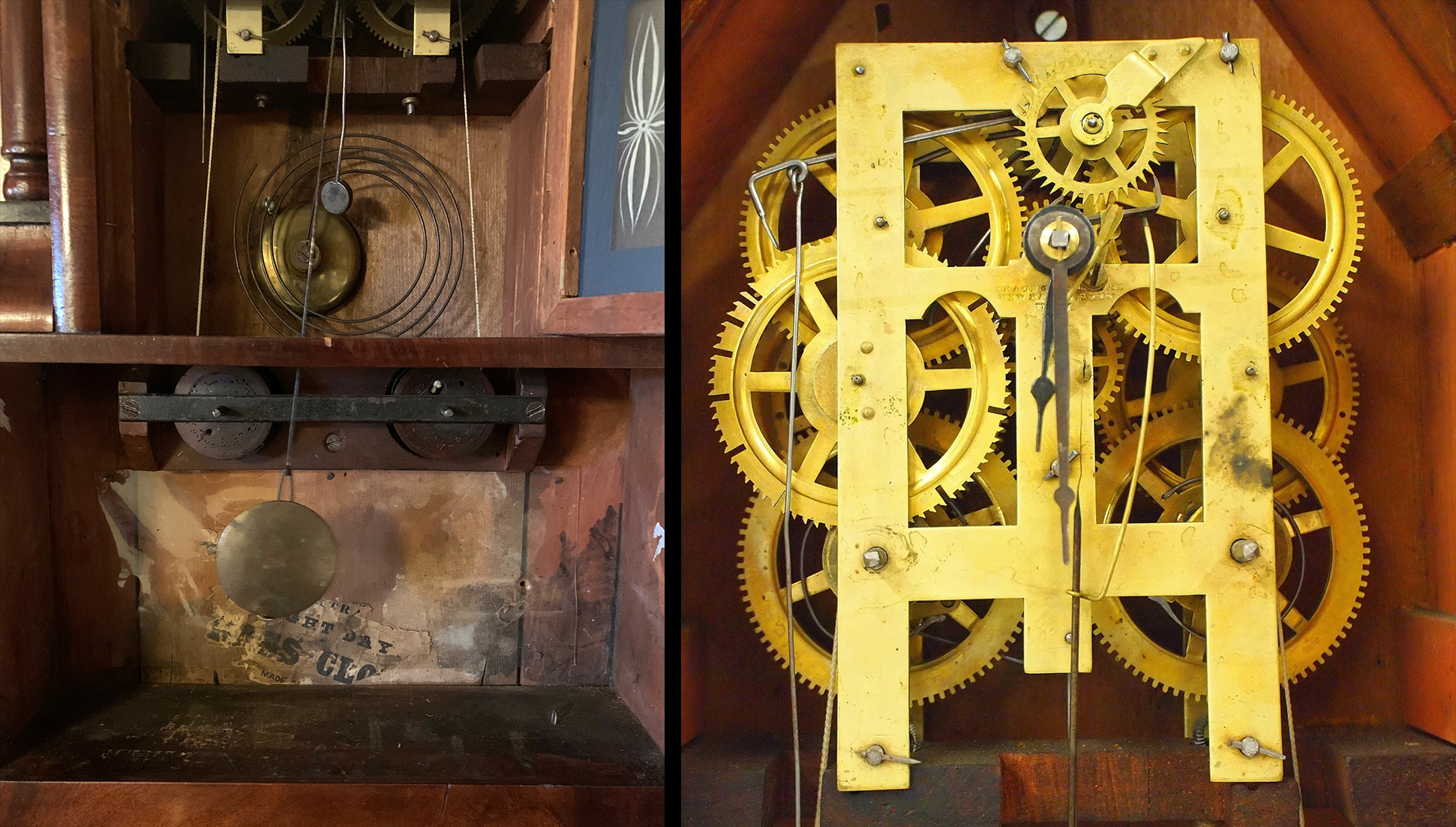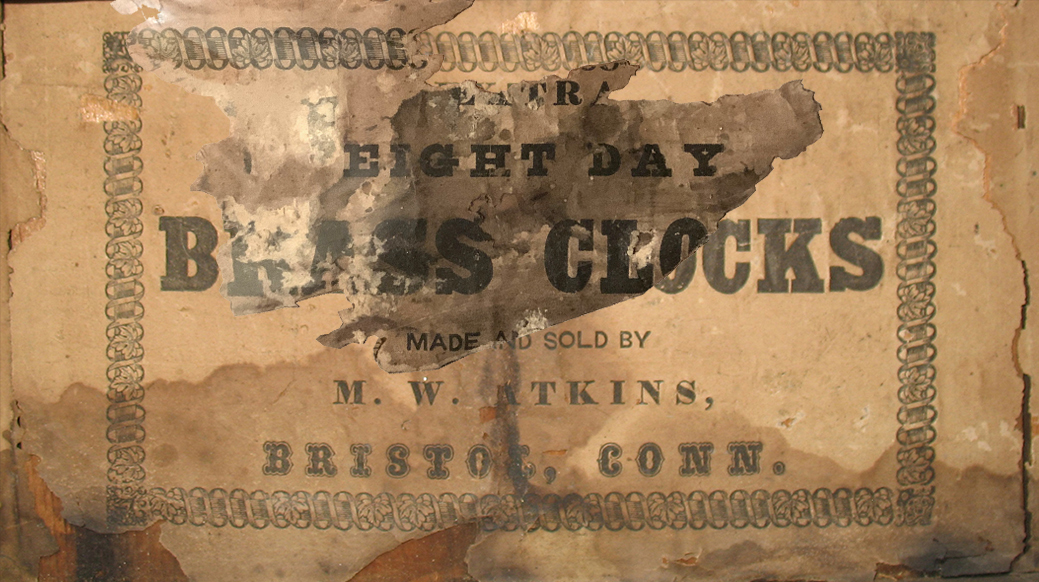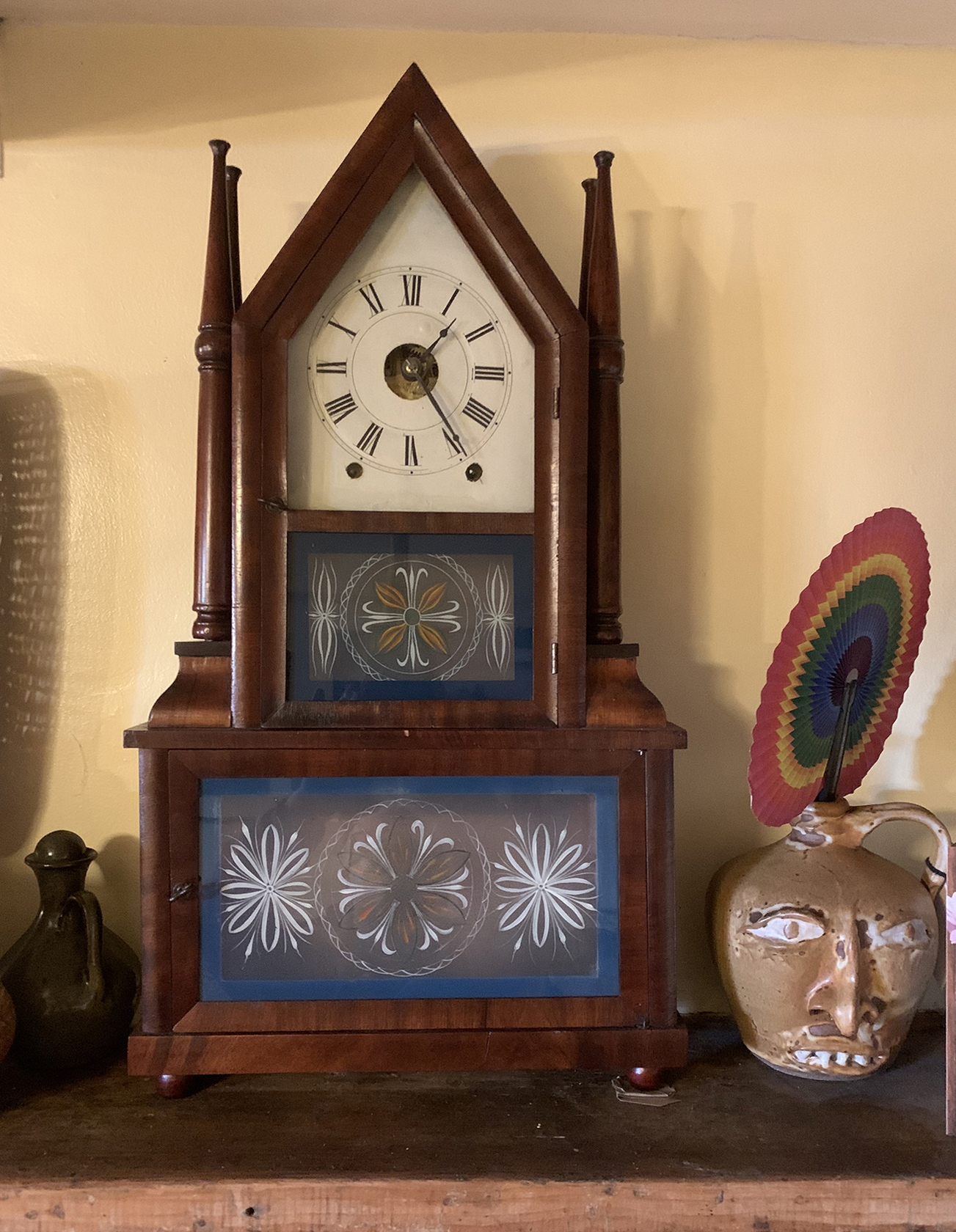Jerome Clock mystery solved

The brass works in the clock purchased last fall is cleared stamped: “CHAUNCEY.JEROME/NEW HAVEN.CONN/USA” (Photo courtesy of Schmidt’s Antiques Inc.)
Kitchen clock search
When we started looking for a 19th-century 8-day shelf clock to sit on the kitchen mantlepiece, it could not have one characteristic common to the other four antique clocks in the house: It couldn’t be weight driven. The deciding factor was the space above the mantlepiece. It’s only 29″; while weight-driven 8-day shelf clocks appear to be at least 30″ tall. (Thirty-hour clocks were available under 29″, but remembering to wind it every day was not a task we were up to. Anyway another 8-day clock would allow us to have just one winding day (Sundays) common with that of the other four antique clocks in the house.)
The two weight-driven 8-day shelf clocks in the house easily exceed the kitchen’s height limitation. (L) The c. 1828-30 Asa Munger clock from Auburn, NY, is 40″ tall, and (R) the Birge & Peck 1845-50 Bristol, CN, clock is 36″. Those heights were needed so that there was enough room for the lead weights to drop over the course of 8 days.
Fortunately by the 1840s American clockmakers were turning to another way to drive their mechanisms: springs.* When one wound spring-driven clocks, you created tension/stress in the spring which would be released over 8 days. The big advantage in manufacturing spring-driven clocks was they could be built smaller, saving money on the case.
* Actually in the late 18th century some American clock makers were producing bracket clocks with a spring-driven movement, but the use of springs in shelf clocks seemed to be abandoned through the early decades of the 19th century. (My guides for American clock-making are the 1976 book “The American Clock” by William H. Distin and Robert Bishop (Bonanza Books, New York) and the 1992 book “The American Shelf and Wall Clocks” by Robert W.D. Ball (Schiffer Publishing Ltd., Atglen, PA).)
Mid-19th-century American clockmakers produced spring-driven clocks with one of three mechanisms: (L) with a wagon spring as in this Birge and Fuller, Bristol, Conn., 30-hour brass-movement clock, (R) with fusées in this Chauncey Jerome, New Haven, CT, 8-day brass-movement clock, and with a coiled spring drive like a fusée but lacks the tapered drum of a true fusée (see diagram below).
(The photo of the Jerome clock on the right was chosen because the missing screws that hold the wooden spools in place allow the one of the springs–a coil of ribbon steel–to be visible.)
I’ll let the diagram above explain the fusée mechanism. It was posted by the Antique Clock Guy (LINK)
Anyway, I didn’t seek out a clock with a fusée-driven movement. It just workout out that way. Last fall looking at online auctions for mid-19th century shelf clocks that fit my needs–8-day and under 30″ tall–and inspired by clocks illustrated in Robert Ball’s book, I started focusing on steeple clocks.
Above is an approximation of what was being offered at liveauctioneers.com last fall. It is a screen shot of auctions for 8-day steeple clocks from October 2023. They show two types: the bottom row of single steeple clocks and the top two rows of double steeple (also called “steeple on steeple”) clocks. And each type could be divided into those with small finials and those with elongated finials (called candlesticks). My preference was towards double steeple clocks, even better double steeple clocks with candlesticks like the Chauncey Jerome clock on the top row and the Birge & Fuller one beside it.
This is the listing from the 14 Oct. 2023 auction by Schmidt’s Antiques Inc., Ypsilanti, MI. The clock was offered by Schmidt’s two other times. On 4 Nov. 2017 the lot was passed with a $1,500-$2,500 estimate and on 31 March 2018 it sold for $900 (plus 20% buyer’s premium) with a $1,000-$1,500 estimate. Then last October it sold to me at $500 (plus 25% buyer’s premium) with a $600-$800 estimate. The descriptions were nearly identical except in 2017 and 2018 it read “runs momentarily when cataloged,” while in 2023 it read “running when cataloged.” The other change was the date. In 2017 and 2018 it was listed as a “19th century” clock, while it was changed to a “late 19th century” clock in 2023, perhaps indicating a lack of confidence as to when it was made.
A Jerome clock or is it?
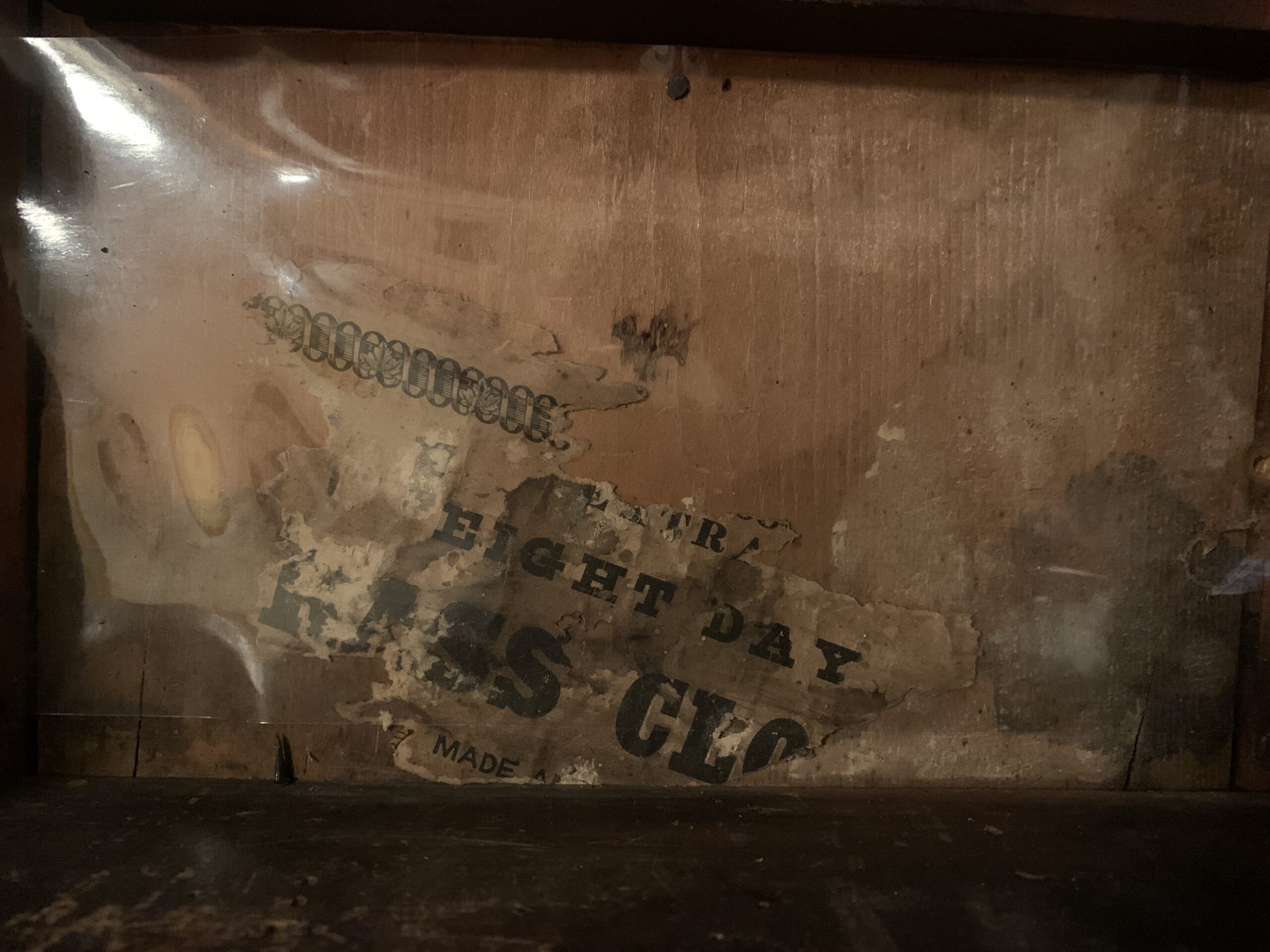
A previous owner or auctioneer sought to preserve the scrap of label by placing an acetate sheet over it.
The issue centered around the “paper label 10% intact.” While the brass works are clearly stamped (see topmost photo in this post) “Chauncey Jerome,” no manufacturers name has survived on the scrap of paper label. Can Jerome label be found to match that scrap? Is the Jerome movement original to the clock? Those are the questions I sought to answer once I got the clock home.
The liveauctioneers.com website provides a pretty good data bank on Jerome clocks. When I do (as of 2 Jan. 2024) a search of auction results for “Chauncey Jerome clock” I got 447 responses. When I narrowed the search to “Chauncey Jerome steeple clock,” I got 42 results including the three listings for the clock I bought. Only the clock I bought has candlesticks and only my clock has a double steeple. Neither of the clock reference books (“The American Clock” and “The American Shelf and Wall Clocks”) show a Jerome clock with a double steeple.
A search on AbeBooks.com for books with “Chauncey Jerome” in the title led me to purchase the above two volumes: (R) a reprint of Jerome’s 1860 autobiography and (L) the 1986 National Association of Watch and Clock Collectors (NAWCC) publication by Chris Bailey on Jerome’s business fortunes. Both provide a fascinating look into the schemes and perils of American mid-19th-century manufacturing.
While the autobiography lacks photos, the NAWCC book had this two-page spread. The left-hand page has a nice view of a single steeple clock with a fusée spring-driven movement, and the other page shows a 1850 Jerome circular for the English trade. Of the offerings only a single steeple “Gothic” clock was offered.
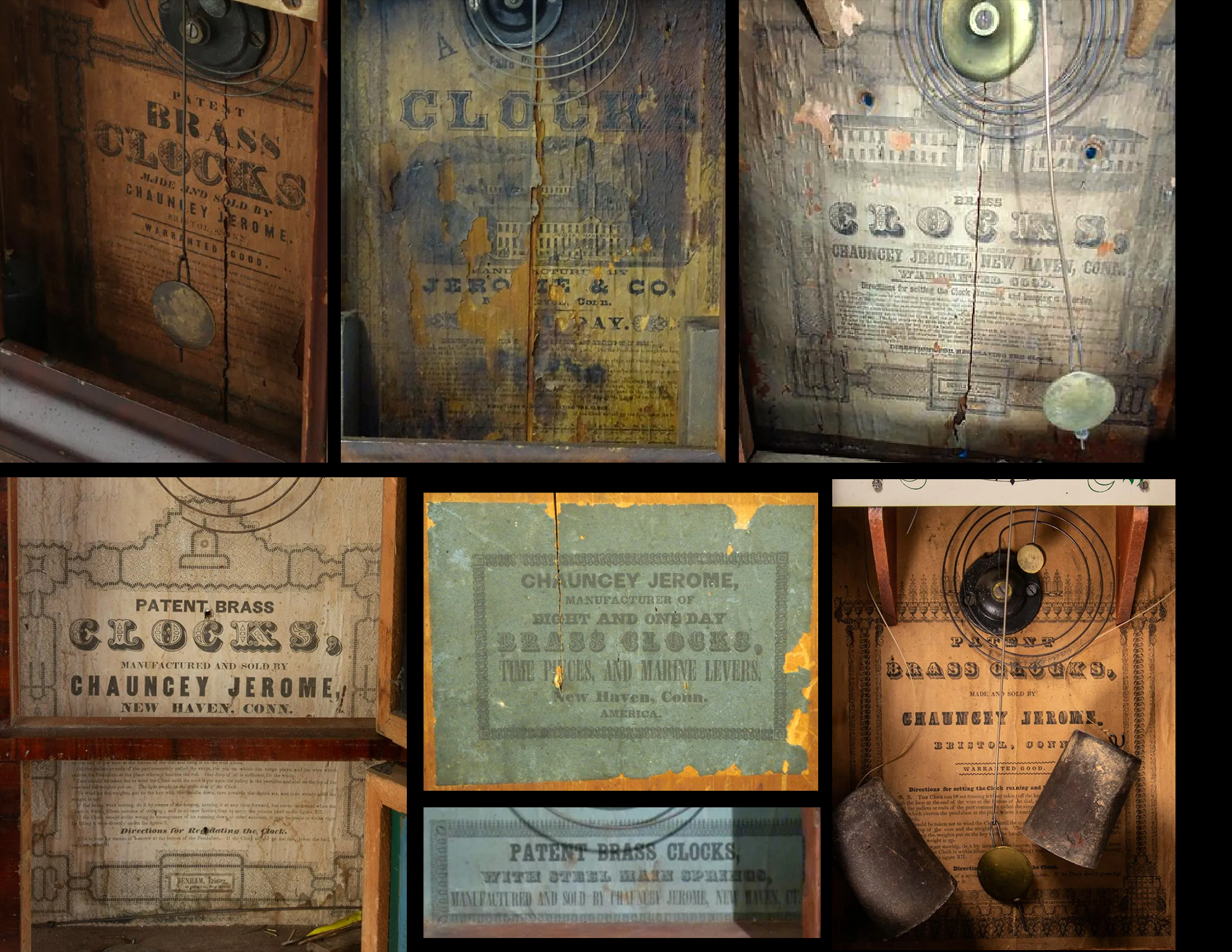
Turning to liveauctioneers.com, I again searched for Jerome clocks in order to view labels. None that I found were a match for the remnant in my clock. Here are a sample of Jerome labels from that search.
Online searches are only as useful as the word or phrase used. Just searching for “Jerome clock” wasn’t producing a breakthrough. But then in early December 2023 I entered “Jerome candlestick clock”, I came upon Mike Bailey’s website jeromeclockcollector.com (LINK).
And when I chose to view his page on “8-day Spring-Driven Brass Clocks,” the above page appeared. Immediately I was drawn to the Adkins candlestick clock on the lower right.
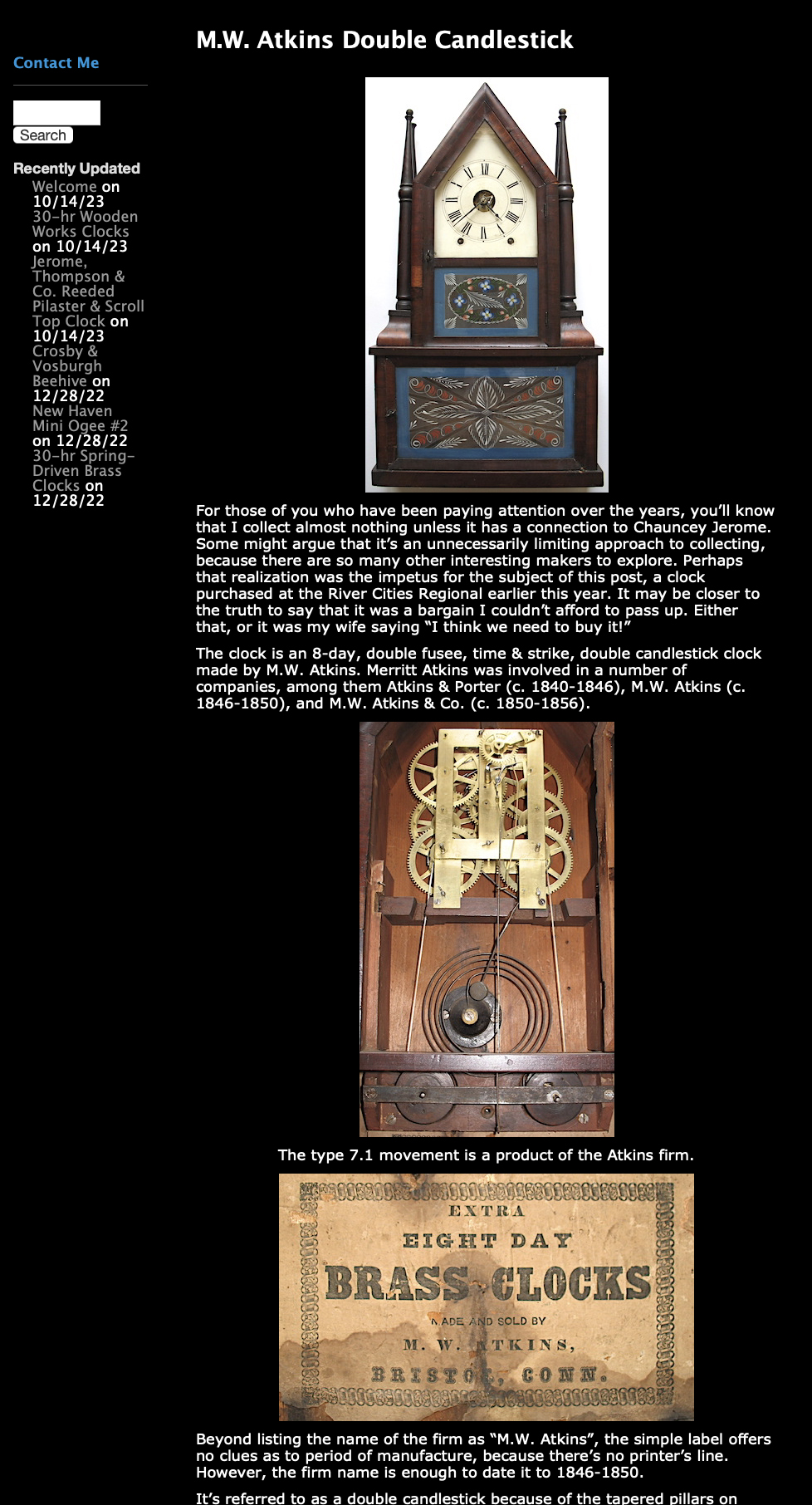 In his Adkins post (LINK), Bailey began: “For those of you who have been paying attention over the years, you’ll know that I collect almost nothing unless it has a connection to Chauncey Jerome.” Yet he bought his one, describing it as “an 8-day, double fusee, time & strike, double candlestick clock made by M.W. Atkins. Merritt Atkins was involved in a number of companies, among them Atkins & Porter (c. 1840-1846), M.W. Atkins (c. 1846-1850), and M.W. Atkins & Co. (c. 1850-1856).” So based on the “M.W. Atkins” wording on the label, he dated the clock to 1846-1850.
In his Adkins post (LINK), Bailey began: “For those of you who have been paying attention over the years, you’ll know that I collect almost nothing unless it has a connection to Chauncey Jerome.” Yet he bought his one, describing it as “an 8-day, double fusee, time & strike, double candlestick clock made by M.W. Atkins. Merritt Atkins was involved in a number of companies, among them Atkins & Porter (c. 1840-1846), M.W. Atkins (c. 1846-1850), and M.W. Atkins & Co. (c. 1850-1856).” So based on the “M.W. Atkins” wording on the label, he dated the clock to 1846-1850.
In the text that follows Bailey mentioned the tiny balls that sit atop two of the candlesticks and that such balls were not found on Birge and Fuller candlestick clocks. He also wrote about the reverse-painted middle and bottom glasses and whether they were the product of William B. Fenn’s shop.*
*Fenn’s shop was known for both free-hand and stencil decorating of Connecticut clock glasses. An online search failed to find much information on Fenn, but an AbeBooks.com search came up with two Chris Bailey publications on Fenn stencils: “Clock Decoration Stencils of mid-19th Century Connecticut” (1984) and “More Clock Decoration Stencils of mid-19th Century Connecticu.” (1994).
Then Mike Bailey wrote: “Bringing this back around to Jerome, during the period this clock was made, Jerome wasn’t really making anything that directly competed (stylistically) with the double candlestick. The closest would have been Jerome’s oversized steeples, but I think everyone would agree that the double candlestick elevates the steeple concept to another level entirely. While I’ve always been struck by the fact that Jerome rarely passed up an opportunity to exploit a niche (high-end clocks being the biggest exception), for some reason he left this niche to other, much smaller firms.
“By the way, as close-knit (even incestuous) as the CT clock-making community was, I can’t find any connection between Atkins and Jerome.”
But that changed when I contacted Bailey about my clock.
I first emailed Bailey on 10 Dec. 2023: “Thanks so much for posting about the W.M. Atkins double candlestick clock. I recently purchased a very similar double fusee 8-day clock with a partial label that appears to match the Atkins one in your post. The movement matches the Type 1.141 Jerome movement stamped Chauncey Jerome/New Haven Conn/USA.”*
*Bailey has pages on Jerome movements. Here’s the link to the page showing what he labeled as “Type 1.141.” Furthermore, Bailey in an email wrote:
“The movement type designation (for example, 1.141) is from the research of Snowden Taylor, in a article titled “Eight-Day Brass Weight Movements of the Noble Jerome Patent Era” (NAWCC Bulletin, Whole No. 270, Vol. 33, No. 1, pages 3-29, February 1991). Snowden was one of the most authoritative experts on 19th century American clocks, and he developed an identification scheme for both 30-hr and 8-day brass movements that used features of Noble [Chauncey’s brother] Jerome’s 1839 patent (#1,200), as well as ones that did not infringe on the patent.”
He replied: “Glad you found that helpful. Seems to me someone posted a similar clock with fragmentary label on the NAWCC message board recently. I wasn’t able to track the thread down again, so not sure if I’m remembering correctly. They’re beautiful clocks.”
I then asked him if I could send him photos of my clock, and he said yes.
On 11 December, I sent three photos and wrote: “There’s just enough of the surviving label to match it with the label on the Atkins double candlestick clock on your website.
“I had been trying to match up the label to ones Jerome used. I even bought a copy of “From Rags to Riches to Rags” the NAWCC bulletin #15, spring 1986, to search for it. Not only did I not see the matching label but didn’t see any photos of a Jerome candlestick clock. I did see on pg. 76, an 1845 Jerome-labeled clock (fig. 147-8) with wooden fusees and an 8-day brass movement like the clock I bought.
“Then I landed on your Atkins post and saw the label match.
“So somehow my clock carried a case used by Atkins with Fenn-painted glasses, a Atkins label but a Jerome movement that was contemporary with the Atkins clock.
“Just though you’d want to know.
“Yours thoughts?”

(L) The Adkins label from the Bailey website and (R) the partial label on my clock. (Left photo courtesy of Mike Bailey)
If I isolate the scrap of label from my clock and position it to correspond to the Atkins label, I get this image.
Then when I slid the scrap atop the Atkins label, it matches up beautifully.
Bailey hadn’t seen this composite when he replied to my 11 December email, but the image (right) would only confirm his conclusion, in which he said;
“Your double candlestick is a beautiful clock. Too bad about the label, but I agree with your attribution to Atkins. My recollection is that a number of these candlestick clocks (possibly could be confusing with the more common steeple on steeple) have been found with Jerome 8-day movements. I think I’ve even seen one with a Jerome movement and Jerome label. The Jerome movement seems to be a perfect fit for your clock, so I assume that Atkins was in need of movements and bought some from Jerome. It’s also quite possible that Jerome traded the movements for some cases, which would explain the one with Jerome movement and label. I do not believe there’s any chance that Jerome was making double candlestick cases. There’s nothing approaching a case that fancy in his late 1840s product line.
“The tablets are absolutely exquisite. There’s a fair amount of debate over whether this style, with a lot of freehand decoration (as opposed to stencil-derived), is the product of Fenn’s shop. However, I’ve seen clocks with definite Fenn stencils paired with a freehand tablet, with matching color palettes. That makes me suspect they were done by Fenn. Others with a keener eye have come to the same conclusion, but I don’t think it’s considered a settled argument.”
So thanks to Mike Bailey and his terrific website and further thanks to his email correspondence, I have my answer: My Jerome clock is actually an Atkins clock. But is the movement married to the Atkins case, i.e. a later substitution for an Atkins movement?
To help answer that question, Bailey scoured the NAWCC message board for candlestick clocks with Jerome movements and found examples but said in a 6 Jan. 2024, email: “It’s possible that the movements are not original to the clocks.” Bailey added: “I’ll keep my eyes peeled for double-candlesticks or steeple-on-steeples with a connection (label, movement, or both) to Jerome. If I find anything, I’ll let you know.”
Yet as to my clock he concluded: “Without question, the Jerome movement fits your case perfectly. From what I can tell, the Atkins and Jerome movements have the same spacing between winding arbors and center shaft, which means that the movements are interchangeable.” So if the Jerome movement replaced an Atkins’ made one, it was a marriage made in heaven.
And now it sits ticking away on my kitchen mantel: M.W. Atkins 1846-1850 8-day candlestick clock with a double fusée spring-driven brass movement made by Chauncey Jerome.
★ ★ ★
Trackback URL: https://www.scottponemone.com/jerome-clock-mystery-solved/trackback/

